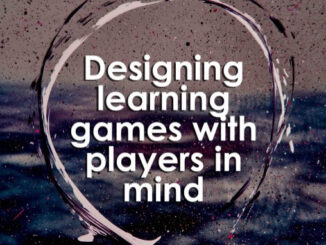
Ludogogy has entered into an agreement with Gamification Journal, based in Seoul, South Korea, for the mutual exchange of articles. This is the sixth of those articles we are publishing and it was in exchange for Sarah Le-Fevre’s article about Flow Theory
The tagline of Ramblr is ‘Photos alone don’t do justice to your trips’. Ramblr specializes in blogging and social posts about mountain climbing and walking. It allows users to go beyond creating a general record of a trip to include storytelling about the place and the experience they have had there.
Ramblr has four main functions – Explore, Track, Share, and Engage. ‘Explore’ is the function to help users plan and create their own trips, by searching information shared previously by other users about the conditions of a location, such as landscape, seasonality, directions, traffic, and the duration of trips.
‘Track’ is where you can record the various kinds of information, whilst taking the trip, including images, video, audio, and text.
Then you can ‘Share’ – uploading the recorded trip to a cloud server to share with all users in a specific group or your social media followers.
Lastly, ‘Engage’ is about expressing feelings. Users can do this by clicking ‘Like’ on the trips of followers or general users, or write comments including up-votes or Q&A.

Storytelling Based on Participation
The functions lead the user through an engagment journey. The ‘Explore’ function has excellent search capability, quickly providing the the trip information the user needs. In turn, this leads them to ‘Track’ so that they can create their own content, and then through ‘Share’, and ‘Engage’ to increase motivation.
Creating content on ‘Ramblr’ is a longer process than content creation on other social platforms. It’s not just uploading a bit of text and some pictures. To make one piece of content, the user must walk steep terrain or run for several hours.
Because the tracked record is shown on a map, the contents cannot be made or counterfeited on the fly. This is different from other social media services. So, user motivation for ‘Track’ needs to be stronger and use different mechanisms than you would find in most social media apps.
‘Engage’ uses the desire for status, fame, and approval as a means of motivation. This is the same functionality as ‘Like’, ‘Comment’, ‘Share’, ‘Follow’, and ‘Views’ (or number of clicks) in traditional Social platforms.
Intrinsic and Extrinsic motivation
Mountain climbing, walking, and traveling always has an objective, and lots of effort is required to achieve it. The primary objective is usually to complete, to get to the end of a planned activity, so the word ‘Conquest’ is quite suitable to use here.
’Conquest’ embraces the meaning of competition with oneself. ‘Climbing a small neighboring mountain’ may be seen as a trivial walk, by some, but to the person who has set themself that goal, it may be something they have planning and building up to for a long time.
Recognition by others is also important, and can be got through a few simple camera technologies and text entries, but the intrinsic motivation of self-esteem through achievement is really key.
General social media users are more affected by extrinsic motivation than intrinsic motivation. The basic instincts of desire to be loved or to be recognized, drive the need for status or reputation. This means that users create another ‘self’ in the platform, beyond the ‘self’ in the real world.
However, ‘Ramblr’ which requires more effort to create content, needs strong additional intrinsic motivation in addition to exisiting intrinsic motivation. So, a strong mechanism for gaining and maintaining self-esteem is required in addition to the recognition gained through posting content for others to see.
Badge, Certificate, Note, Achievement
Intrinsic motivation mechanisms in ‘Ramblr’ are ‘Badge’, ‘Certificate’, ‘Note’, and ‘Achievement’.
‘Badge’ and ‘Certificate’ which are issued when the user conquers a mountain summit or finishes the walking path, are the key intrinsic motivation mechanisms. A ‘Badge’ is provided as recognition when the user approaches the target point in their trip. It’s real-time-based and a reward for users’ effort and success.
’Certificate’ is basically the same concept as ‘Badge’, but is different because it checks the authenticity and quality of real work. When the user uploads and shares the completed ‘Trip’ in the cloud server, the official ‘Certificate’ of achievement is issued after checks. It’s very similar to a real certificate. Also, the users can attach a picture to the certificate as a ‘certificate picture’.

‘Note’ is the online form of a general stamp notebook. It collects records of ‘Badge’ and ‘Certificate’ for mountain climbing and travel. It provides longer-term intrinsic motivation than ‘Badge’ and ‘Certificate’.
’Note’ can be used as a user’s personal notebook that does not include any objectives set by the app. Users can set their own long-term objectives, such as ‘I will conquer 50 mountains this year’. Another type of ‘Note’ is a ‘Mission Note’ with pre-determined objectives. For example, the objective ‘Conquer the top 100 mountains in Korea’ is pre-defined and linked to collecting the ‘Badge’ and ‘Certificate’.
‘Achievement’ is calculated in points by considering the number of mountains, trip distances, number of shares of trip information, and participation on social media. The point score represents the status of the user in the user community, and can be converted into R-Cash (online cash in the platform) and used to purchase the ‘Note’, etc.

Motivation and Engagement through game mechanism
These four mechanisms’ resultant stats and status can be seen by other members in a user’s profile, so it may be related to some extrinsic motivation. However, this process requires considerable time, and mental & physical effort, so the power of intrinsic motivation to encourage content creation is strong.
’Ramblr’ started as a general blogging and social media platform, but after applying the gamification mechanisms such as ‘Badge’, ‘Certificate’, ‘Note’, and ‘Achievement’, the level of content creation has exponentially increased. This has made a virtuous cycle of ‘Share – Engage – Explore’, connecting the original extrinsic motivation mechanisms.
- Photos Alone Don’t do Justice to your Trips - 9th June 2022





Be the first to comment